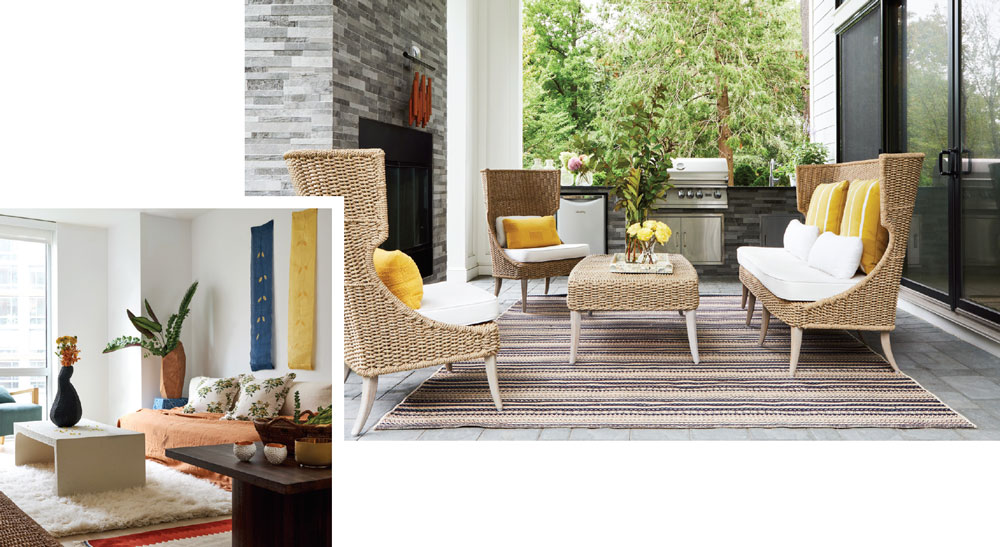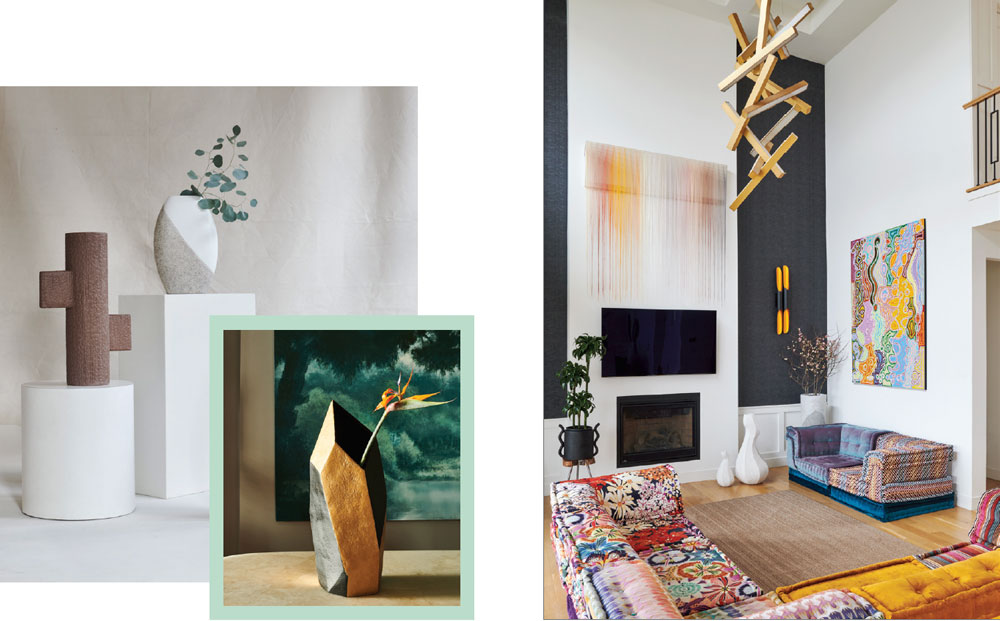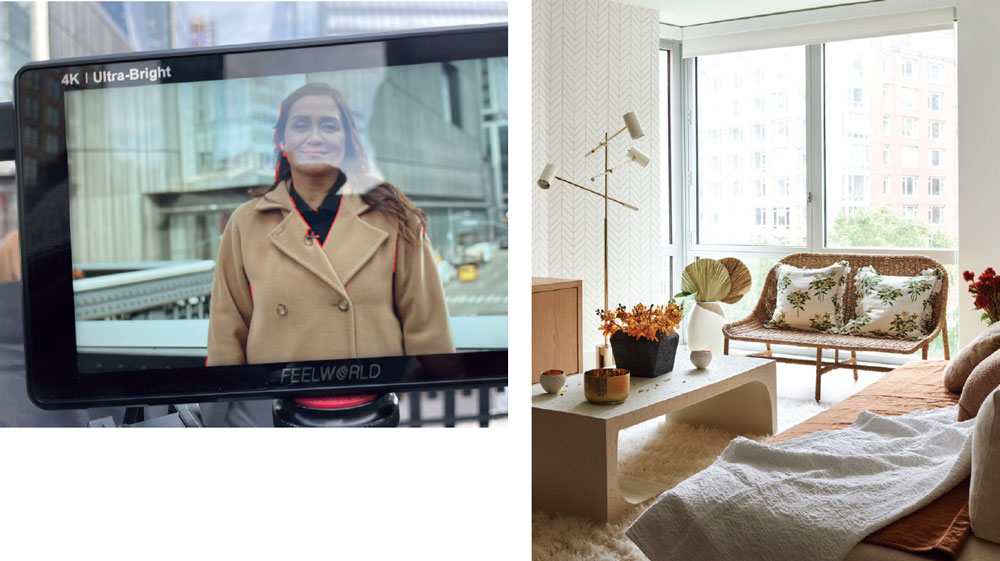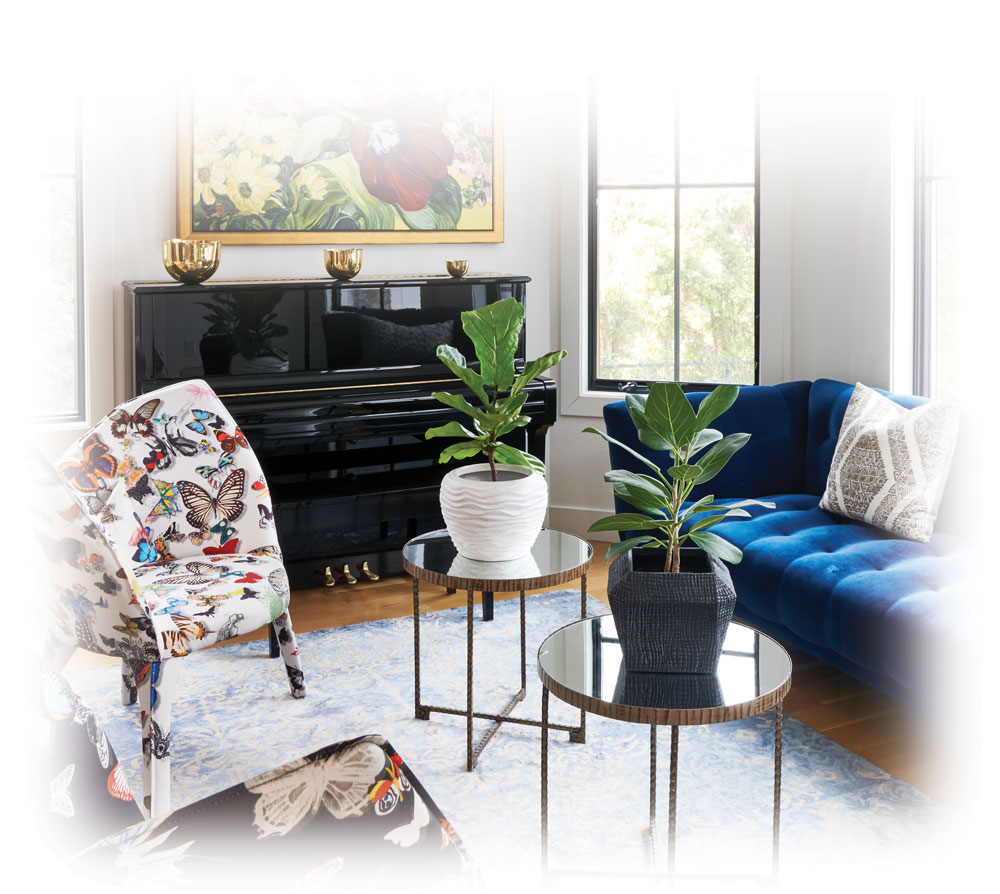What design tools, approaches, frameworks, and techniques can your company use to make your retail business more
sustainable? Laurence Carr has suggestions.
Furniture World asked designer Laurence Carr to answer questions about her mission-driven pursuit of circular
and
sustainable practices. She founded Laurence Carr Inc., a regenerative, multifaceted design firm based in New
York City,
specializing in interiors that embody sustainability and healthy living. She also leads Studio Laurence, a
sustainable
luxury home goods brand focused on zero-waste product design.
Carr serves on the advisory board of the United Nations Fashion and Lifestyle Network, is a member of
Maison&Objet’s
judging committee for the Sustainable Track, and is a notable writer and speaker on sustainability and the
circular
economy. She is also the executive producer and host of Chez Laurence, an EarthxTV original docuseries.
Question: Please describe your path to founding Laurence Carr Inc., becoming executive producer
and host of the EarthxTV
original series Chez Laurence, and advocating for circularity and sustainability.
Laurence Carr: Having lived and worked on four continents, I found that the immersion of
cultures enhanced my artistic
perspective and ignited a desire to protect our planet’s natural resources and beauty. That was the path to
founding my
design firm, Laurence Carr Inc., and advocating for the importance of circularity in the built environment while
working
with manufacturers that embrace zero-waste processes and production methods. As an international interior
architect and
product designer, I specialize in creating sustainable interiors and designing home goods that intertwine
sustainability
and mindful luxury. I also consult on sustainable business management.
In the mid-2010s, I noticed how notions of well-being and sustainability were separate from any conversation
within the
home furnishings industry. My mission has always been to inform architecture and design professionals, consumers
and
companies about sustainable practices and the circular economy. This focus led to opportunities to take on
impactful
roles with global stakeholders and leading international organizations.
My docuseries, “Chez Laurence,” showcased an urgent need for circular and sustainable innovation. Episodes
featured
discussions about circularity with executives from brands at the forefront of this movement in interiors,
hospitality,
home furnishings, and the built environment. The goal was for audiences to come away with a stronger
understanding of
circularity, why it matters, and how it impacts our future.

Designer Laurence Carr
“Circular design focuses on creating products, services and systems with resource efficiency, durability
and longevity,
repairability, life cycle assessment, reuse, upcycling, shared economy and biodiversity in mind.”
Question: How do you approach your work as an interior and
product designer?
Laurence Carr: My design company, Laurence Carr Inc. (laurencecarr.com), started with
residential projects in New York
City and the tri-state area. However, as an interior designer focused on creating sustainable spaces, I had
trouble
finding sustainable, circular home furnishings to work with. Hence, I decided to launch my studio and
collaborate with
international manufacturers that demonstrated circular practices within their proprietary product portfolios. I
launched
Studio Laurence (studiolaurence.com) with a capsule collection of circular vessels in collaboration with
Nature’s
Legacy, Inc. There are upcoming collaborations with furniture manufacturing companies, but I can’t say more
about that
now.
My active advocacy for wellness, healthy materials, and sustainable practices also led to invitations to partner
as a
brand ambassador with organizations, participate in trade showhouses and perform on-site installations at US and
European industry shows.
Question: Are there challenges to bringing sustainability and circularity to people of average
means?
Laurence Carr: I work in the luxury market, and my clients are mostly in the UHNW
(ultra-high-net-worth) category. I
believe the sustainable movement trickles down from the high end to the mass market, leading by example.
In 2021, getting third-party certifications for luxury manufacturing home brands was an education and a
difficult,
costly process. People were just starting to become aware of the benefits of HEPA filters! Good indoor air
quality was a
new notion. Following the global pandemic, the population shifted its focus to health and wellness in home, work
and
travel environments.
Since then, acceptance of climate change has progressed, and limits to finding circular products and healthy
materials
in the US and abroad have been erased. Demand has increased for furniture made of biomaterials, and the mass
market now
offers sustainable food, fashion, home and lifestyle products. Emblematic of this trend is Target’s recently
launched
home products line in partnership with Lenzing.
In addition, leading industry organizations, such as mindful Materials (mindfulmaterials.com), the International
Living
Future Institute (living-future.org), International WELL Building Institute (wellcertified.com) and the Business
Institutional Furniture Manufacturer Association (bifma.org) have partnered to make a revolutionary shift to
bring
healthy materials to the built environment. Global commercial companies, architects, designers and industry
stakeholders
are joining the mission. Healthy materials and transparency are being normalized.”
Question: What’s the imperative to work towards a more sustainable, circular industry?
Laurence Carr: Circularity has the potential for far more potent impact than sustainability
alone, yet it remains
somewhat of an unknown concept.
Circularity in design is a product and system design approach that aims to minimize waste and efficiently use
resources.
It’s a departure from the traditional linear ‘take-make-dispose’ model of production and consumption. Instead,
circular
design focuses on creating products, services and systems with resource efficiency, durability and longevity,
repairability, life-cycle assessment, reuse, upcycling, the shared economy and biodiversity in mind.
Furniture companies can benefit from reorganizing their supply chains, production cycles, and materials sourcing
and
from better understanding their products’ life- cycle assessments. Every generation and every consumer is
looking into
third-party certifications, waste management and design for longevity, reuse, and even repair services.”

Laurence Carr’s interior design work incorporating principles of sustainability and circularity.
Question: Is there a downside for furniture manufacturers and retailers who fail to address
these issues?
Laurence Carr: At some point, furniture companies that ignore these issues will face many
challenges. They will lose
market share to competitors because of consumer demand shifts, regulation, cost issues and brand reputation.
Question: In 2021, you worked on Salon de la Circularité at the October High Point Market. What
was your experience?
Laurence Carr: Designing a vignette for High Point Market Authority’s Sustainable Stories
activation was a pleasure. At
that time, the project was an excellent opportunity to invite HPMKT to be part of my EarthxTV series. My team
and I
sourced all furniture and accessories with circularity in mind. Creating regenerative interiors is a philosophy
that
extends beyond design into conscious consumerism and life cycle thinking.
With “Salon de La Circularité” we hoped to pass a message to interior designers about the value of designing
long-lasting luxury interiors. We did that by repurposing items or finding new uses for old pieces. When buying
new
furniture, I look for standard third-party certifications that verify sustainable manufacturing processes and
support
local artisans and manufacturers when possible. I chose healthy selections such as renewable, recycled or
upcycled
materials and natural fibers such as linen and hemp for textiles.
It was a great experience working with Cisco Pinedo (of Cisco Home), Libeco Textiles and Lenzing to commission a
sofa
using circular materials inside and out. The Phillips family enthusiastically collaborated, providing pieces
from the
Phillips Collection. The Mill Collective and local artisans contributed upcycled metal lighting and wooden
chairs to
this project.
Question: Is the U.S. far behind in adopting sustainable practices?
Laurence Carr: Europe, particularly the Scandinavian countries, has led the way in promoting
the circular economy and
regenerative practices. The U.S. has caught up and is transforming its throwaway economy into one where waste is
progressively eliminated.
However, there is a long road ahead. I recommend Furniture World readers check out the Ellen MacArthur
Foundation’s
website (ellenmacarthurfoundation.org). It’s one of the best online resources for learning about circular
economy
principles. Included are a collection of examples and case studies illustrating how companies embed the
principles of
the circular economy in their design process. With a systems-thinking approach, products and materials can
circulate for
longer and avoid becoming waste while also regenerating natural ecosystems.
“There is a long road ahead. I recommend Furniture World readers check out the Ellen MacArthur
Foundation’s website.
It’s one of the best online resources for learning about circular economy principles.”
Question: People in the U.S. can’t even trust where their recycling ends up. Is this lack of
trust a problem?
Laurence Carr: The pathway to a solution is education, education, education! The furniture
industry needs to take the
time to explain to clients and consumers the health benefits of surrounding oneself with healthy materials and
products.
Once they understand, a mindset shift begins. Consumers of all generations are learning about sustainable
products
versus greenwashing. Third-party certifications are a real thing. Educating consumers that VOCs or PFAs are
endocrine
disruptors, and can cause serious diseases, is key.
Another excellent online resource is the Sustainable Building: Materials Guide for a Healthy, Circular,
Affordable
Future course (cpe.newschool.edu/certificates), created by the Parsons School of Design. Any furniture retailer,
architect or designer can take this course to learn about healthy materials, sustainability and circularity. The
U.S.
Green Building Council website (www.usgbc.org) is helpful for further understanding the relationship between
human
health and environmental attributes.
Question: What can retailers do to help incentivize and inform customers about circularity and
sustainability?

Vessel capsule collection designed by Studio Laurence and a living room by Laurence Carr
incorporating principles of
sustainability and circularity.
Laurence Carr: Besides highlighting their sustainability value proposition, retailers need to
inform consumers with
clear third-party certification labels, create educational displays and train staff. They can also incentivize
consumers
with sustainable discounts, trade programs and financing options.
Question: What home furnishings companies are leading the way in promoting refreshing,
renewing, recycling and
circularity?
Laurence Carr: Here are some: Room & Board, GreenRow (Williams- Sonoma Home), IKEA, West Elm,
Lenzing, Libeco, Cisco
Home, Andreu World, Keilhauer, Mater, Kvadrat, Loose Parts and COCO-MAT..
Question: Is there a relationship between caring for yourself and caring for the world by
making
sustainable choices?
Laurence Carr: Absolutely! Health and wellness are inextricably linked. Healthy materials
contribute to wellness. There
is a relationship between caring for oneself and caring for the world through the act of making sustainable
choices.
Homeowners can enjoy physical and mental peace of mind knowing that non-harmful products—healthy materials from
insulation to paint, floorboards, kitchen countertops, energy-efficient devices, wood cabinets, mattresses,
sheets,
rugs, and decor—surround them.
The triple bottom line involves caring for the planet, sourcing healthy products, and caring about people while
making
profits.
“The future of furniture’s second life might include hybrid retail business models—combinations of
buyback programs,
resale platforms and customization, and technology integration with augmented reality.”

Carr filming Chez Laurence EarthxTV in NYC and a Laurence Carr designed NYC Living Room.
Question: Are some furniture retailers looking to create a second life for their products?
Laurence Carr: IKEA has a test store that collects data on consumer interest in secondhand
furniture, tests pricing
strategies, and examines the logistics of refurbishment and resale.
It could become a profitable model for other retailers if they find that they can resell at competitive prices
and
generate large-scale consumer demand. The future of furniture’s second-hand life might include hybrid retail
business
models—combinations of buyback programs, resale platforms and customization, and technology integration with
augmented
reality.
Furniture retailers might also investigate working in partnership with their municipalities on waste management,
disposal of furniture remnants, upcycling some parts and engaging in public and private partnerships for
investment to
strategize their supply chain and production for a more sustainable approach.
Question: Are there challenges convincing consumers to pay more for used furniture vs buying
new?
Laurence Carr: Globally, 36% of consumers are willing to buy second-hand, with a higher
percentage among younger
generations. Sustainability, affordability, and uniqueness are major factors that they care about.
The concept that second-hand furniture is less desirable than new is a societal issue. Older generations, like
boomers
and Gen X, might not perceive ‘second-hand’ as a benefit. However, millennials and Gen Zs embrace the circular
economy
and understand sharply that climate change is a reality; there is no planet B. In 2024, buying second-hand and
vintage
is more than a trend. Purchasing products from second-hand retailers in the fashion and home sectors is part of
the
sustainable living movement.

Pictured is Laurence Carr (far left) leading a home furnishings industry panel at HPMKT. The topic:
“Big Shift: Why
Circular Design is the Way of the Future.”
Panelists (l-r) were Cisco Pinedo, Susan Inglis, Kathryn Richardson and Chad Bolick.
Question: Do you envision the necessity for the government to set a regulatory environment to
accelerate the realization
of a circular economy?
Laurence Carr: I serve on the Advisory Committee of the United Nations Fashion Lifestyle
Network. This online platform
serves as a hub for industry stakeholders, media, governments and UN entities to collaborate on achieving
Sustainable
Development Goals (SDGs) within the fashion and lifestyle sectors.
I do envision the necessity and opportunity for the government to set up a regulatory environment to embrace
circular
economy practices in different industries and sectors.
Education is key. I recently completed a certificate in Sustainability Business Management at the University of
Cambridge. Learning about government policies is essential to moving forward. It takes a village to make
impactful
changes leading to a sustainable future.
Question: Aside from you, where Is leadership in sustainable and circular design coming from in
the furniture business?
Laurence Carr: Many global furniture industry trade shows are leading the way in promoting
sustainability and
circularity. Furniture retailers should know that Salone del Mobile has an amazing sustainability program.
NeoCon in
Chicago has a Sustainability Lab led by Metropolis magazine. Organizations such as mindful Materials, IFLI and
the WELL
Institute are partnering to revolutionize the built environment. Maison&Objet recently focused on sustainability
for its
30th anniversary. ICFF/Wanted Design in New York (wanteddesignnyc.com) is doing its part. Every European and
Asian trade
show has embraced this message as have global retailers such as Andreu World and its circular design challenge
program.
Keilhauer, Mater, Kvadrat, and Mohawk Group, are other leaders in this effort.
Question: What concepts regarding refreshing, renewing, recycling and circularity should
Furniture World readers know
more about?
Laurence Carr: They should be aware that creating beautiful and functional products informed by
biodiversity, inspired
by nature and made with renewable energy sources and materials improves their customers’ quality of life. I
would direct
them to the Living Product Challenge 2.0 standard created by IFLI, the International Living Future Institute
(living-future.org). It’s the world’s most advanced product sustainability standard. The framework encourages
manufacturers to create healthy and inspiring products and give more than they take across the life cycles of
their
products. Becoming a professional member and taking their online course on that topic is easy.
Question: What steps would you advise a furniture retail operation to take to achieve circular
and sustainable goals?
Laurence Carr: Every case is different. I would provide advice on the company’s supply chain,
production or operations
that would benefit the most from investment and innovation to improve sustainability practices. For example,
applying
new technologies, product designs and business models and then determining how those changes might contribute to
revenue
improvement.
I would investigate how the company could innovate in each business area to promote sustainable practices. These
might
include design approaches, tools, frameworks, or techniques to make identified areas more sustainable, such as
bio-mimicry, LCA and frugal innovation. I would also look for ways to overcome any barriers to implementation.
Question: Has progress been made in other industries that can serve as a model for the
residential home furnishings
industry?
Laurence Carr: The apparel industry promotes overconsumption and generates significant textile
waste. However, it’s made
progress using sustainable materials, second-hand platforms and rental models. These options support the reuse
and
repair of garments and upcycling, which are circular economy principles. The furniture industry has started to
explore
similar options online and in some brick-and-mortar operations.
There’s a long way to go, but these are successful strategies the furniture industry should to consider to
promote
sustainability and circularity.

Music room by Laurence Carr